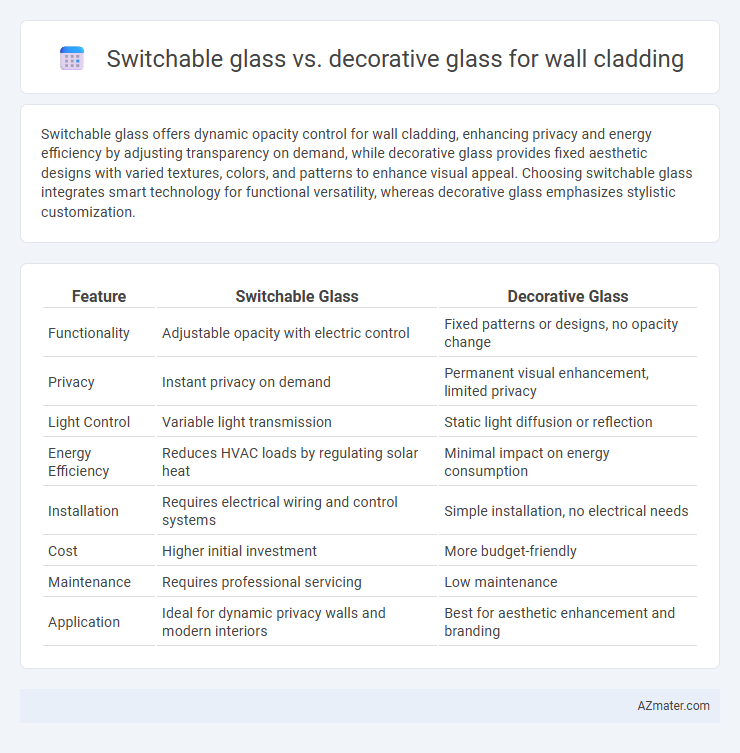Switchable glass offers dynamic opacity control for wall cladding, enhancing privacy and energy efficiency by adjusting transparency on demand, while decorative glass provides fixed aesthetic designs with varied textures, colors, and patterns to enhance visual appeal. Choosing switchable glass integrates smart technology for functional versatility, whereas decorative glass emphasizes stylistic customization.
Table of Comparison
| Feature | Switchable Glass | Decorative Glass |
|---|---|---|
| Functionality | Adjustable opacity with electric control | Fixed patterns or designs, no opacity change |
| Privacy | Instant privacy on demand | Permanent visual enhancement, limited privacy |
| Light Control | Variable light transmission | Static light diffusion or reflection |
| Energy Efficiency | Reduces HVAC loads by regulating solar heat | Minimal impact on energy consumption |
| Installation | Requires electrical wiring and control systems | Simple installation, no electrical needs |
| Cost | Higher initial investment | More budget-friendly |
| Maintenance | Requires professional servicing | Low maintenance |
| Application | Ideal for dynamic privacy walls and modern interiors | Best for aesthetic enhancement and branding |
Introduction to Modern Wall Cladding Solutions
Switchable glass offers dynamic control over privacy and light transmission, making it an innovative choice for modern wall cladding solutions in commercial and residential spaces. Decorative glass enhances aesthetic appeal with customizable patterns, textures, and colors, providing design flexibility without compromising durability. Both materials contribute to energy efficiency and modern architectural trends, with switchable glass emphasizing functionality and decorative glass focusing on visual impact.
What Is Switchable Glass?
Switchable glass, also known as smart glass, is an advanced technology that changes from opaque to transparent when an electrical current is applied, offering privacy control without compromising natural light. Unlike decorative glass, which primarily serves aesthetic purposes with static patterns or textures, switchable glass allows dynamic light management and energy efficiency in wall cladding applications. This innovation enhances versatility in modern interior design by combining functionality and style for offices, homes, and commercial spaces.
Exploring Decorative Glass for Wall Cladding
Decorative glass for wall cladding offers versatile design options featuring patterns, textures, and colors that enhance aesthetic appeal while providing durability and easy maintenance. Unlike switchable glass, decorative glass does not change opacity but excels in adding artistic expression and customization to interior spaces. Popular materials include tempered or laminated glass with printed, sandblasted, or frosted finishes, ensuring safety and style in residential and commercial applications.
Aesthetic Appeal: Switchable vs Decorative Glass
Switchable glass offers dynamic aesthetic appeal by seamlessly transitioning between transparent and opaque states, providing customizable privacy and modern sophistication for wall cladding. Decorative glass enhances visual interest through intricate patterns, textures, and colors, delivering a timeless artistic statement. Combining both options can elevate interior design by balancing functionality with bespoke artistic expression.
Privacy Features and Control
Switchable glass provides dynamic privacy control by transitioning from transparent to opaque at the flip of a switch, allowing instant privacy without sacrificing natural light. Decorative glass offers fixed privacy through etched, frosted, or patterned designs, which obscure visibility but do not allow for adjustable transparency. Switchable glass is ideal for spaces requiring flexible privacy control, while decorative glass suits environments where permanent aesthetic privacy is preferred.
Flexibility in Design and Customization
Switchable glass offers unparalleled flexibility in design by allowing dynamic transparency control, enabling spaces to shift between open, light-filled areas and private zones with the flick of a switch. Decorative glass, while rich in aesthetic options such as etched patterns, colors, and textured finishes, provides static visual appeal without the ability to change functionality. Customization in switchable glass integrates technology with creative design, making it ideal for adaptable environments, whereas decorative glass excels in delivering permanent artistic expression for wall cladding.
Energy Efficiency and Environmental Impact
Switchable glass enhances energy efficiency by dynamically controlling solar heat gain and natural light, reducing reliance on artificial lighting and HVAC systems. Decorative glass, while visually appealing for wall cladding, typically lacks the advanced thermal regulation properties of switchable glass, leading to higher energy consumption. Environmentally, switchable glass contributes to lower carbon footprints through energy savings and reduction in HVAC usage, whereas decorative glass primarily offers aesthetic value without significant environmental benefits.
Durability and Maintenance Considerations
Switchable glass offers high durability with integrated PVC films that resist scratches and impacts, requiring minimal maintenance beyond standard cleaning. Decorative glass for wall cladding varies in durability based on coating and printing methods; some types may require protective treatments to prevent fading or damage. Both options demand regular cleaning, but switchable glass's active technology necessitates occasional electrical component checks to ensure functionality over time.
Cost Comparison: Switchable Glass vs Decorative Glass
Switchable glass typically incurs higher initial costs compared to decorative glass due to advanced technology and power requirements for opacity control. Decorative glass offers a more budget-friendly option for wall cladding, with lower material and installation expenses while still providing aesthetic appeal. Long-term operational costs can increase for switchable glass because of electricity consumption and maintenance needs.
Choosing the Right Glass for Your Wall Cladding Project
Choosing the right glass for your wall cladding project depends on functionality and aesthetic goals; switchable glass offers privacy on demand through electrochromic technology, making it ideal for multipurpose spaces requiring dynamic light control. Decorative glass enhances visual appeal with customizable patterns, textures, and colors, perfect for statement walls and branding elements. Evaluate factors such as privacy needs, light diffusion, maintenance, and budget to determine whether smart switchable glass or expressive decorative glass best aligns with your design objectives.

Infographic: Switchable glass vs Decorative glass for Wall cladding
 azmater.com
azmater.com